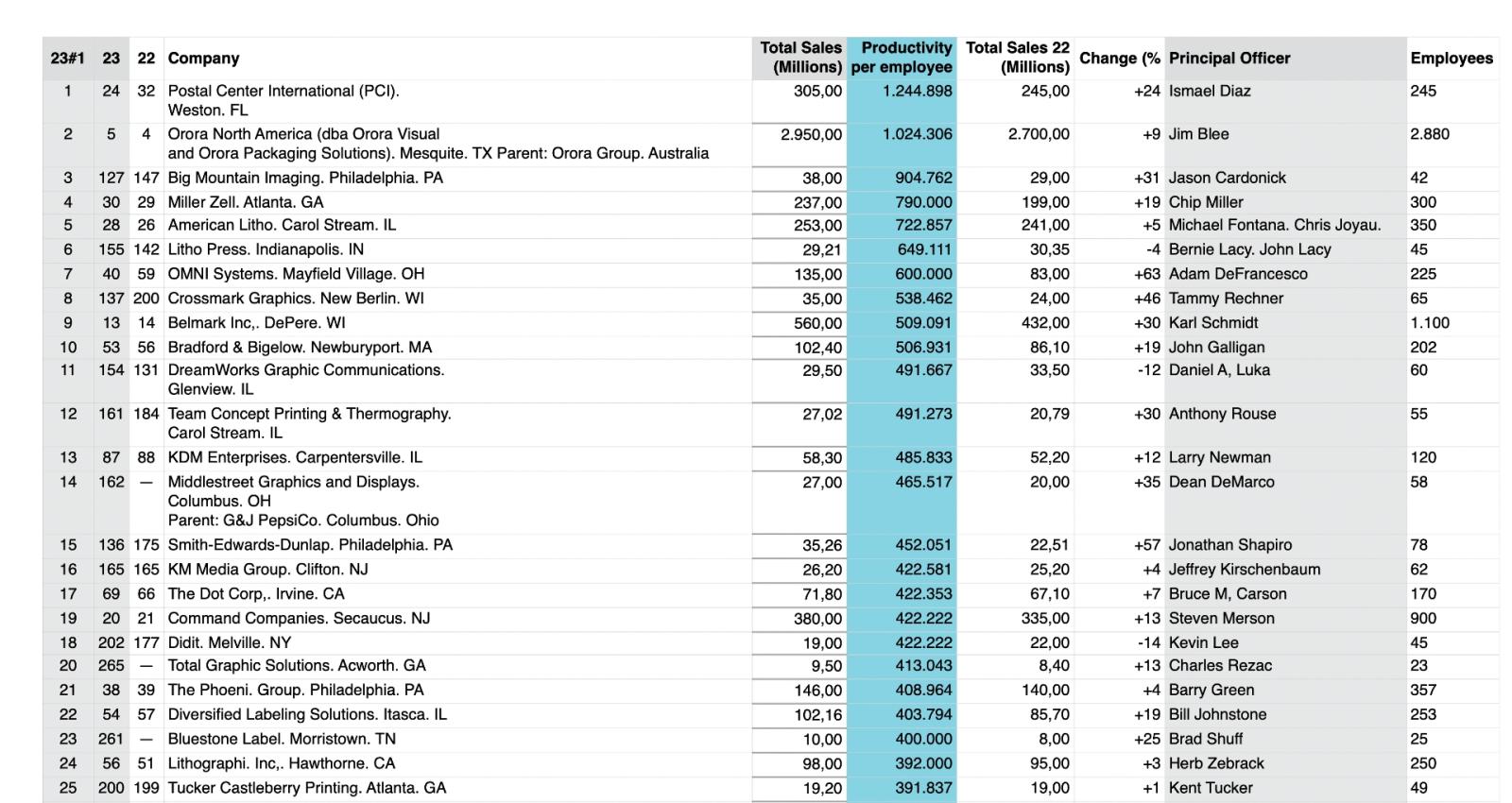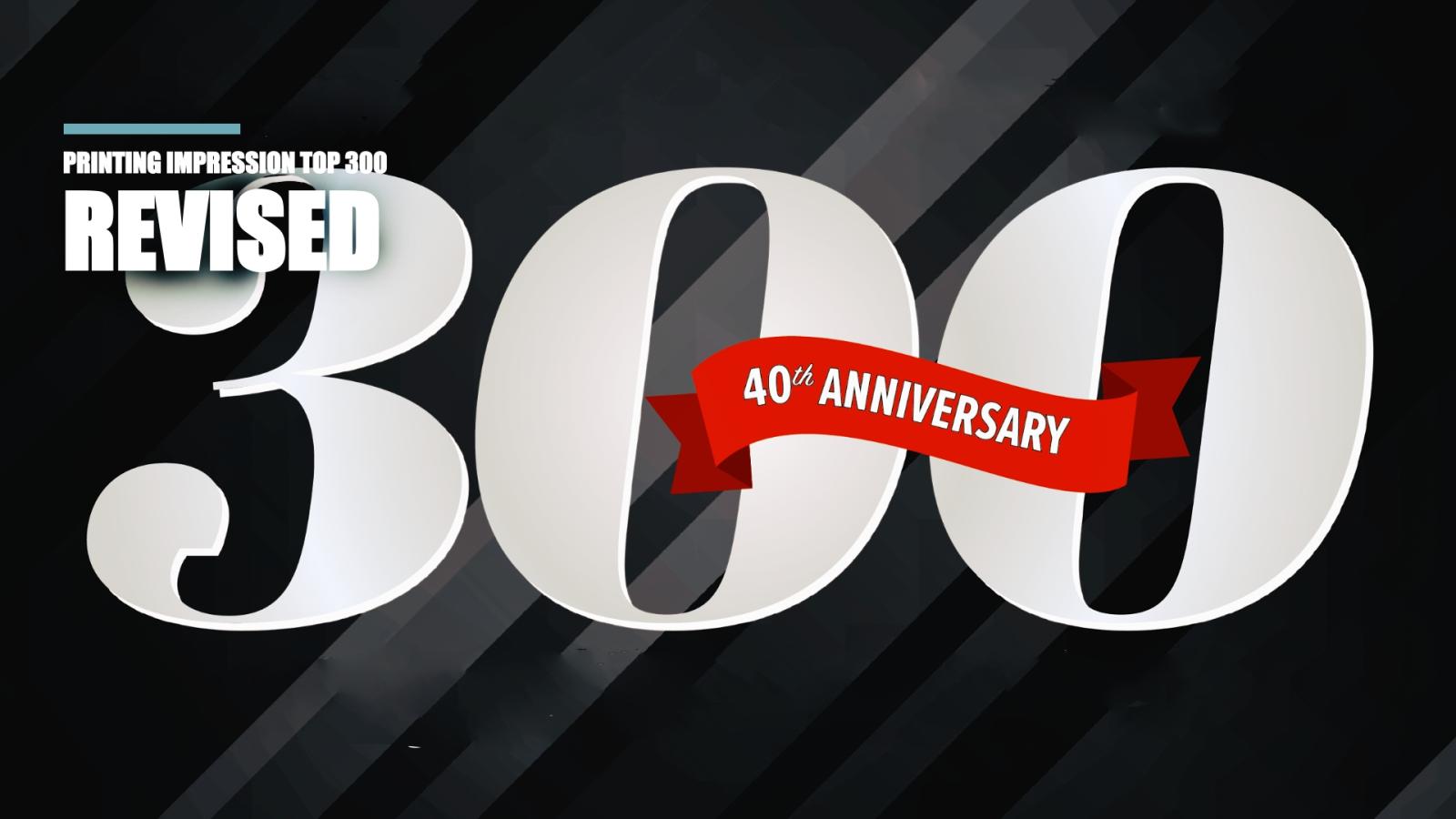A few days ago, Printing Impressions published their latest Top 300 edition about the printing Industry of America. Once again, I think it's a shame that my friends at Printing Impressions don't add my suggestion of having productivity as a measure to their annual list - so let me explain the idea and why it's essential in my view!
By Editor Morten B. Reitoft
When you get a list of companies based on revenue, you can, of course, see how big the most significant companies are, and you can see how they develop year over year. But how can you relate the data to your company? Well, in my view, the only valuable measure is productivity. Productivity is another word for how efficiently these companies make money; you can compare it directly with your business.
One way of measuring productivity is by taking revenue and divide with head counts - and that's exactly what I have done.

A few funny takeaways when you sort the list based on productivity rather than revenue is that the largest companies, like RR Donnelley, end up as number 227 rather than number one. The Top 300 list also shows some names that are not as known and famous as the RR Donnelley - i.e., number one on the productivity list is Postal Center International (PCI), with a revenue of 305 million dollars, delivered by only 245 employees. That gives them a productivity of $1,244,898 per headcount - and the first thing you have to ask yourself is, why is the productivity so high? What does the company do? And is there any logical reason why PCI is so much higher than the list's average of $262,014?
Visiting the PCI website hints at why productivity is so high - they are a transaction printer serving 2,000,000,000 mail yearly. If a part of their revenue is postage, passed on with zero or tiny profits, this will bump up the productivity. At PRINTING United in Dallas in 2019, I got to talk to Vice President of Operations Perry Fernandes from PCI. Listen to the interview here.
However, my point is that if you are a transactional printer, it makes more sense to look at how efficiently they can develop the revenue and, when compared to your own - use that as a growth objective.
Another printing company on the list is Litho Press, Indianapolis. Based on revenue, they would come in as number 155, but they are number 6 on productivity. The revenue for 2023 was a bit less than $30 million. Still, the revenue was delivered with only 45 employees, giving them a productivity per employee of $649,111 or more than twice the average of the Top 300. We also visited Litho Press - and what is interesting about Litho Press is that they have changed their business over time. As Vice President of Sales Bernie Lacy explains, hadn't they changed to packaging years ago, he doesn't believe the company would still exist. But listen to the interview here - it's a great inspiration in my mind.
The two examples above are essential to understand why the list should add productivity as a measure, but how can you use productivity in your business?
Before continuing - productivity is not a measure of whether you have a good business. Profit is the only thing that counts in that perspective.
Identify your productivity - and again, divide your revenue by the number of full-time employees. Now identify your competitors on the Top 300 list - if they are among them.
If your productivity is lower than your competition, you now have an objective of either bringing headcounts down or an aim to increase your revenue. That knowledge can be used for an action plan that can be made very operational. Typically more sales activities, better marketing and communication, a review of your prices to your customers, etc.
If your productivity is higher than your competitors, now is also the time to make a plan. Assuming that you are profitable, you have one massive advantage in your pursuit of increasing your revenue - you know exactly how much you can afford to spend - because the difference between your and your competitor's productivity is your potential spending - on new employees, activities, new investments, etc.
This is, of course, simplified, but you wouldn't be able to do that without using the available data in a redefined way and making it into something that can be used - rather than just, well - gossip :-)




Fri October 15th
Abundância de provas...
O Que Os Papéis Dizem-Semana de 11 de outubro-Por Nessan Cleary
Fri October 8th
A Austrália ainda es...
O Que Os Papéis Dizem-Semana de 4 de outubro-Por Nessan Cleary
Fri October 1st
A cobertura desta se...
O Que Os Papéis Dizem-Semana de 27 de setembro-Por Nessan Cleary
Fri September 24th
Mais sinais de cresc...
O Que Os Papéis Dizem-Semana de 20 de setembro-Por Nessan Cleary
Tue September 21st
A experiência de imp...
INKISH cobre o evento, e mal pode esperar para conhecer a indústria é este talvez primeiro evento físico na Europa:-)
Fri September 17th
Há boas notícias sob...
O Que Os Papéis Dizem-Semana de 13 de setembro-Por Nessan Cleary
Sat September 11th
Perguntas sobre o es...
O Que Os Papéis Dizem-Semana de 6 de setembro-Por Nessan Cleary
Fri September 3rd
Estas semanas histór...
O Que Os Papéis Dizem-Semana de 30 de agosto-Por Nessan Cleary
Fri August 27th
Pesquisadores encont...
O Que Os Papéis Dizem-Semana de 23 de agosto-Por Nessan Cleary
Wed August 25th
Você nunca vai inves...
O que faz PSPs relutar em investir?
Assine
Receba Notificações para se inscrever em nosso informativo
Login (login)
Novo Usuário (novo_usuário)? Registre-se (registre)
Apague Senha (apague_senha)
Registre-se (registre)
Usuário Existente (existente_usuário)? Login aqui (login_aqui)
Login aqui (login_aqui)
Apague Senha (apague_senha)
Por favor entre seu endereço de email registrado Você receberá um link para resetar a sua senha via email (rest_senha_descrição)
Novo Usuário (novo_usuário)? Registre-se (registre)